In 1893 Swiss-born banker and philanthropist Henry Rosenberg presented Galvestonians with a way to quench their thirst for water and beauty at the same time. In his will, he bequeathed $30,000 - the equivalent of almost $860,000 today - for the “creation of not less than 10 drinking fountains for man and beast in various portions of the city of Galveston.”
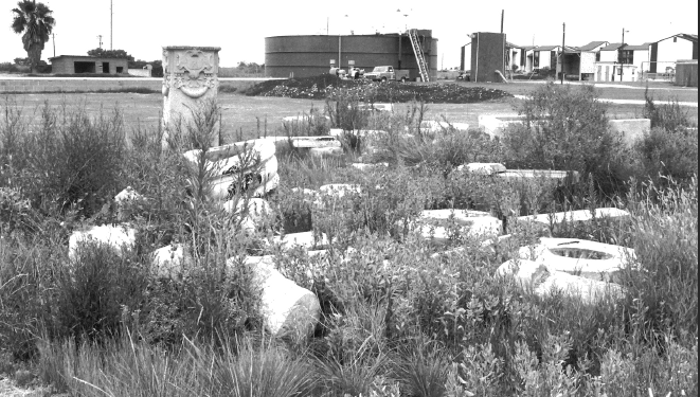 Executors of Rosenberg’s estate contracted Scottish-born sculptor John Massey Rhind to design a series of granite fountains for Galveston with separate water sources for humans, horses and dogs. Three of the designs were produced in triplicate, and each bore the inscription “Gift of Henry Rosenberg.”
Executors of Rosenberg’s estate contracted Scottish-born sculptor John Massey Rhind to design a series of granite fountains for Galveston with separate water sources for humans, horses and dogs. Three of the designs were produced in triplicate, and each bore the inscription “Gift of Henry Rosenberg.”
The first twelve fountains were placed in March of 1898, one in each of the twelve wards of the city. Five larger, more expensive creations were installed six months later in Sherman Park, Lasker Park, Central Park, at the Union Railway Station and one block north of the original City Hall.
In three locations that featured fountains solely for human use, additional animal troughs were added nearby, raising the total number of water sources to twenty.
However, structures that survive devastating hurricanes don’t necessarily survive the march of time. When automobiles began replacing horses, the fountains began to disappear. Within a few years most of the structures had been dismantled and fragments left at Scholes Field, a city work lot, the Pelican Island viaduct or taken to private gardens. Some of the granite was crushed to be incorporated into concrete for city projects.
By the beginning of 1994, only three large and two small fountains were still standing. Concerned citizens collected remaining fragments, and stored them in the old train yard behind Shearn Moody Plaza. That is where Charles Meek, of Santa Fe, found them and began dedicating the rest of his life to their restoration.
His extensive research included documents, photographs and original drawings of the fountains held by private citizens and the Galveston & Texas History Center at the Rosenberg Library. With these tools he was able to puzzle together existing parts of the fountains, which were originally named only with the letters “A” through “Q,” as well as duplicate missing portions to facilitate the reconstruction of the structures.
Galveston owes him a debt of gratitude.
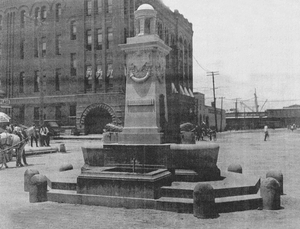 THE FOUNTAINS
THE FOUNTAINS
Design A - 23rd Street between Sealy & Ball
Now located on the grounds of the Rosenberg Library, this was the largest and most expensive of all of the Rosenberg fountains. Its original design featured two four-foot-long bronze fish whose mouths offered spouts for water supplying the “people” basin, and whose tails entwined bronze tridents. Basins for dogs are recessed in a platform at each end of two rectangular horse troughs, and a tapered center column is adorned with seashells and bellflower wreaths on each side.
The original location of this fountain is believed to have been in the median on 25th Street, between Strand and Mechanic, and a bird’s-eye view photo of the city taken in 1915 shows it standing at 25th Street and Santa Fe Place. Its most memorable location for thousands of visitors and Galvestonians is standing in the Broadway esplanade at the entrance to the city. It was dismantled during the Broadway widening in 1951, and re-erected at the library in 1995.
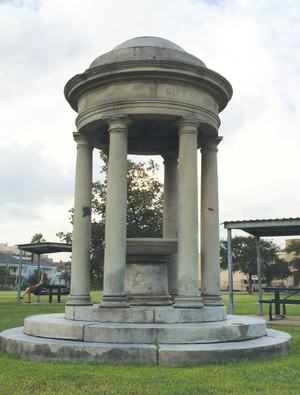 Design B - 12th Street and Ball
Design B - 12th Street and Ball
This fountain sits behind Rosenberg Elementary in Adoue Park. Reminiscent of Roman design, its circular basin sits on a pedestal atop three concentric circular steps with six columns rising to support a center dome. The fountain originally stood in a park and has since switched places with a school. When the new Rosenberg School was built on the park lot, the fountain was moved to the old school site, which became the new park
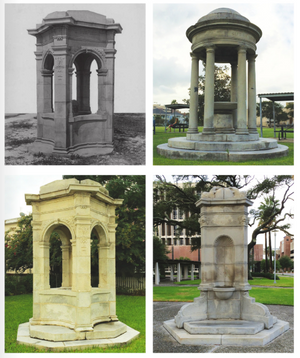 Design C - 21st and Ball
Design C - 21st and Ball
Arguably one of the most unique of the designs, its triangular structure rises from a hexagonal platform, with three stone fish anchoring the bottom corners. Originally a two-foot bronze fish adorned each of the sides within arched niches. First erected in the center of Central Park in front of the original courthouse, it was moved in 1909 to the corner of Ball and 21st Street at the edge of the park. When new courthouse was built in 1966, it was moved toward the corner.
Design D - 15th and Ball
Currently nestled on a quiet corner of the East End Historic District, this fountain has an octagonal base with a square pavilion. Arched openings decorated with carved palm fronds leading to a curved central basin. Its earliest installment was at Morris Lasker Park at 40th Street and Ball.
Later, in the 1940s and 50s, the fountain occupied a grass plot adjacent to the popular Jack Tar Hotel on the east side of 6th Street at Seawall.
Design E - 21st and Postoffice
Re-erected in 1995, this fountain is the largest horizontal fountain of all of Rhind’s designs. Featuring a curved horse basin on the concave side of the central wall, a lion’s head drinking spout for humans on the convex side and two lower dog basins at each end, this fountain stretches nearly 16 feet in length.
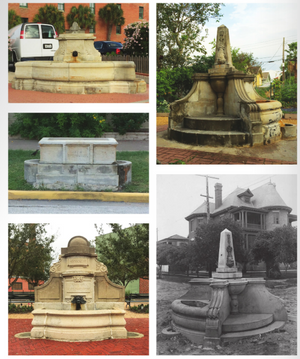 The style is reminiscent of design observed by members of society on the “Grand Tour” that was once regarded as a valuable part of education. It once stood in the middle of 20th Street at the south edge of the Strand, but was dismantled in 1949.
The style is reminiscent of design observed by members of society on the “Grand Tour” that was once regarded as a valuable part of education. It once stood in the middle of 20th Street at the south edge of the Strand, but was dismantled in 1949.
Design F - 21st and Strand
Once erected by the Beach Hotel near 23rd Street and Water (now named Seawall), this small design features a horse trough with dog basins on each end of one side, and a Lone Star emblem and circular basin for humans on the other. The hotel burned just a few months later in July 1898, and the fountain began its migration.
An undated picture shows the intact fountain (including a bronze fish waterspout) in front of the Klondyke Saloon, which may have been at 29th and Water. A mystery ensues with a 1918 picture of the fountain in front of a building labeled Barney’s, which may have stood at 31st and Seawall. By the time this photo was taken three major pieces had been replaced with cast concrete in a design that does not conform to the original. No one knows why or when this occurred. In 2016 it was relocated to it's current location in Hendley Green Park, 2028 Strand.
Design J, K, L - 16th and Broadway
 With none of the three original examples of this fountain in existence, Meek produced scaled drawings of this design from a watercolor representation. Incorporating one of the last remaining fountain stones in storage, a horse basin, he then cast the missing parts, and assisted with the details of the fountain’s re-erection. It is one of only three remaining fountains with an active water supply.
With none of the three original examples of this fountain in existence, Meek produced scaled drawings of this design from a watercolor representation. Incorporating one of the last remaining fountain stones in storage, a horse basin, he then cast the missing parts, and assisted with the details of the fountain’s re-erection. It is one of only three remaining fountains with an active water supply.
Re-dedicated at William Temple Episcopal Center at 427 Market, it was removed to the Galveston Historical Foundation offices in the 1940 Sears Building for temporary storage. It now sits in a privately held park on the corner of Broadway and 16th Street.
Unnamed Basin - 10th between Winnie and Ball
This simple, gray granite horse trough with dog basins is the only one of the fountains to remain at its original location. Sitting beside the Rosenberg school, it was unfortunately filled with concrete and is now unusable.
Design M, N, O - 2005 Avenue N ½
Tucked into the San Jacinto Neighborhood Community Garden is a small round fountain that was originally one of three identical creations. Two horse basins were all that remained of the original fountain when Meek produced scale drawings from an original photograph, which showed it standing in front of Cordray’s Drug Store at 15th and Postoffice. He then recast the missing pieces. An obelisk about
four feet high rises from the center of a basin divided into quadrants, with 36-inch sea creatures (originally bronze) containing spouts to provide the water.
Lost to Time
There is only one photo of one of three fountains created from design “G-H-I,” and no remaining pieces are known. A picture of style “P,” also known as the “Convent Wall Fountain” dated 1918 was located at the curb of 27th Street between Avenues N and O.
The classic, curved wall of fountain “Q” or the “Cemetery Fountain” with its large beast head spout exists only in an artists’ rendering.